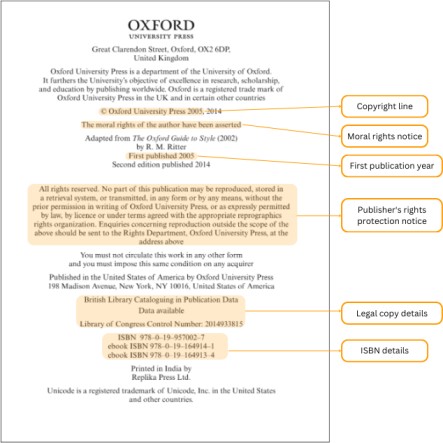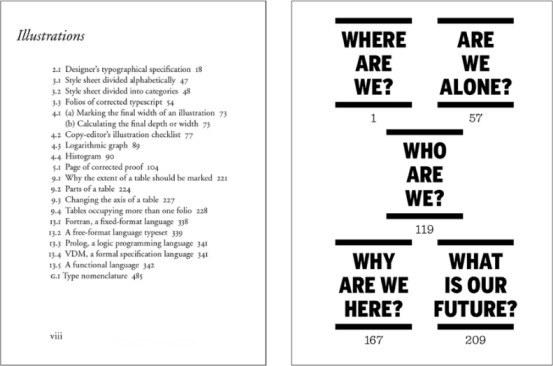Preliminary pages (prelims) in a book comprise the introductory section before the main content, featuring elements like the title, authorship, copyright and table of contents, providing essential information about the book’s publication details and structure. They serve as a prelude to the core narrative or informational content within the book, playing a crucial role in providing essential information, context and structure for the reader. Additionally, they may express gratitude, set the tone with an epigraph and offer guidance through a table of contents. The foreword or preface may provide insights into the book’s background or purpose. Altogether, the preliminary pages contribute to the overall reader experience, enhancing comprehension and engagement with the main content of the book.
Preliminary pages are usually numbered with Roman numerals (i, ii, iii, iv, …) and consist of the following elements:
- half-title page
- frontispiece
- title page
- copyright page
- dedication page
- epigraph
- list of figures/tables
- acknowledgements
- foreword/preface
- repeated half-title page
Half-title page: Page i
The first page of a book is its half-title page, sometimes called the ‘bastard title.’ This will be a recto (right-hand page) and, it will be page i, though the page number is usually not printed on it.
The half-title page should consist only of the book’s title in a typeface (font) consistent with the book’s cover or interior design, which is normally centred and positioned somewhat above the centre of the page. For instance, between a fifth and sixth of the way down the page from the top margin is a good spot to place the title.
Frontispiece: Page ii
Page ii (the reverse of the half-title) is normally blank but can contain a relevant image. It is referred to as the ‘frontispiece.’
Title page: Page iii
Page iii will normally be the title page with all relevant information about the book. This should include:
- title
- subtitle, if any
- name(s) of the author(s) or editor(s)
- publisher name and/or logo
Optionally, it may also include:
- publisher’s location
- publication year
- descriptive text
- illustration
As with the half-title page, the page number is also often not printed on this page.
Copyright page: Page iv

Page iv (the reverse of the title page) will normally be the copyright page. This page includes copyright information, such as the copyright holder, publication date and any disclaimers. It may also provide details about the book’s printing or edition. The copyright page should include the following information:
- publisher details
- ISBN number
- copyright notice
- legal copy details
- edition information (if any)
- any legal notices/disclaimers required
It may also optionally include credits for editing, design, production and illustration. Like the frontispiece and title page, this page often does not carry a page number.
Copyright page template
Here is a template for the copyright page for a self-published book. To complete it, replace the dots with the information about your book.
| © ………[author and year of first publication] |
| The moral right of ……… [the author] has been asserted |
| This book is sold subject to the condition that it shall not, by way of trade or otherwise, be lent, resold, hired out, or otherwise circulated without the publisher’s prior consent in any form of binding or cover other than that in which it is published and without a similar condition including this condition being imposed on the subsequent publisher. [This notice is inserted to protect the publisher’s rights.] |
| First published in ……… [place and year of first publication] by ……… [publisher] |
| Library of Congress Control Number: ……… |
| ISBN ……… |
| Designed by ……… [the designer] |
Dedication: Page v
Some books include a dedication page where the author expresses appreciation or dedication to specific individuals or groups. This page is often the first numbered page of the book — usually page v. Normally, it is set in the same size as the main text in the book but centred. Sometimes, the dedication may be set in italics.

How to write a good dedication?
When writing a dedication for the preliminary pages of a book, it is important to keep it concise while still conveying your appreciation or sentiments. Here is a guide on how to write a good dedication page:
- Start with the address: Begin with a formal salutation or address to the person or group you dedicate the book to. For example: ‘To my dearest family,’ or ‘In honour of…’
- Express gratitude: Clearly state your gratitude or appreciation. You might say, ‘For their unwavering support’ or ‘In grateful acknowledgement of…’
- Be specific: Mention the names of the individuals or group you dedicate the book to. This adds a personal touch and shows that you have thought specifically about the people involved.
- State the reason: Briefly explain why you dedicate the book to these individuals. It could be their support, inspiration, encouragement or any other meaningful contribution to your journey.
- Use authentic language: Choose words that convey genuine emotions. If it is a dedication to family, express love and warmth. If it is to mentors or colleagues, communicate respect and gratitude.
- Keep it brief: Remember that the dedication page is not the place for a lengthy essay. Keep your dedication short and focused, usually a few sentences to a short paragraph.
- Proofread carefully: As with any part of your book, proofread your dedication carefully to ensure no grammatical errors or typos. This is a special part of your book, so you want it to be flawless.
Epigraph: Page vi
An epigraph is a quotation or brief statement that precedes the main text and often sets the tone or theme of the book. It may be used at the start of the book, at chapter heads or both. When used at the start of a book, it may appear on a recto (right-hand page) on its own page at this point or can sometimes appear on a verso (left-hand page) facing the table of contents or the first page of text.
How to choose a good epigraph?
Choosing a good epigraph for the preliminary pages of a book can enhance the overall tone, theme or message of your work. Here are some tips on how to choose a meaningful and effective epigraph:
- Relevance: Ensure that the epigraph is relevant to the content of your book. It should provide insight into the themes, subject matter or tone of the work. Readers should be able to connect the epigraph and the main text.
- Quotations from influential figures: Selecting a quote from a well-known or respected person in the field related to your book can lend authority and credibility to your work. It can also offer readers a perspective they might find interesting or thought-provoking.
- Literary connection: If your book falls within a specific genre or literary tradition, choosing an epigraph from a classic work or a well-known author in that genre can provide context and engage readers who appreciate that style.
- Contrast or irony: An epigraph that contrasts with the main content of your book or introduces an element of irony can be intriguing. It may encourage readers to think more deeply about the material.
- Personal significance: If you have a favourite quote or a saying that holds meaning to you and aligns with the theme of your book, it can add a unique and authentic touch.
- Length and language: Keep the epigraph concise. A short, impactful quote is often more effective than a lengthy one. Additionally, consider the language of the epigraph — it should be clear and easily understood by your target audience.
- Permission: If the chosen epigraph is from a copyrighted source, ensure you have the necessary permission to use it in your book. Some works may be in the public domain, while others may require permission or attribution.
List of figures/tables: Page vii
If the book includes illustrations, photographs, figures or tables, a list (along with the page number) may be provided on page vii so the readers can identify and locate them. The number and type of tables will vary depending on the type of book. Fiction books rarely include figures, charts or tables but may include illustrations or photographs. Non-fiction books, depending on the subject, more often include tables, diagrams or charts.

Acknowledgements: Page viii
The acknowledgement page is a place for the author to thank particular individuals or institutions — usually those who have helped in the research, writing and/or production of the book.
Foreword/preface: Page ix–x
A foreword is usually written by someone other than the author and provides additional context or endorsement for the book. A preface, if written by the author, may serve a similar function as an introduction. In this case, it explains the purpose, background or circumstances surrounding the book’s creation and content.
Unlike the foreword, a preface is generally written by the author and falls outside the scope of the book’s main content — its argument (non-fiction) or story (fiction). It is a space where the author can speak directly to the reader about their motivation in writing the book and discuss their inspiration and intention.
Repeated half-title page: Page xi
Some books repeat the half-title page. This is particularly the case when preliminary pages are long.
How to prepare preliminary pages for publication?
Professional proofreading is the systematic review and correction of written material to ensure grammar, spelling, punctuation and overall presentation accuracy before publication. Proofreading is a crucial step in the book publishing process, and according to the Chartered Institute of Editing and Proofreading, ‘a proofreader will be expected to proofread these pages and cross-check any details such as page numbers in the contents list with actual page numbers.’ Here is some more information about how professional proofreading contributes to the preparation of these pages for publication:
- Ensuring accuracy and consistency: Proofreading helps identify and correct spelling, grammar and punctuation errors to ensure the accuracy of information on the preliminary pages. Moreover, it helps maintain consistency in formatting, style and language throughout the front matter, providing a polished and professional appearance.
- Enhancing readability: Proofreading helps improve the overall readability of the preliminary pages by identifying and fixing awkward phrasing or unclear sentences.
- Adhering to style guidelines: Publishers often have specific style guidelines that authors need to follow. Proofreading ensures that the preliminary pages adhere to these guidelines regarding formatting, citation style and other editorial requirements.
- Checking page numbers and headings: A proofreader verifies the accuracy of page numbers and ensures that headings, subheadings and other elements are correctly formatted and in the correct order.
- Verifying copyright information: The copyright page is a critical element of prelims. Proofreading ensures that all copyright information, including the publication date, ISBN and other details, is present, accurate and up-to-date.
- Detecting typographical errors: Typographical errors can easily go unnoticed during the writing and editing phases. Proofreading helps catch these errors, preventing embarrassing mistakes in the final printed or digital version of the book.
Final thoughts
In conclusion, preliminary pages in a book are a crucial part of the publication process. They provide essential information about the book’s publication details and structure, serve as a prelude to the core narrative or informational content and contribute to the overall reader experience by enhancing comprehension and engagement with the book’s main content. Thus, by following the above guidelines, writers can ensure that their books are presented in the best possible light while readers can navigate the book with ease and have a more meaningful experience.
If your preliminary pages or the book manuscript need proofreading, contact me for a free sample edit of your text (and remember to use my early bird discount). I am an experienced editor working with non-fiction, academic and business books.


